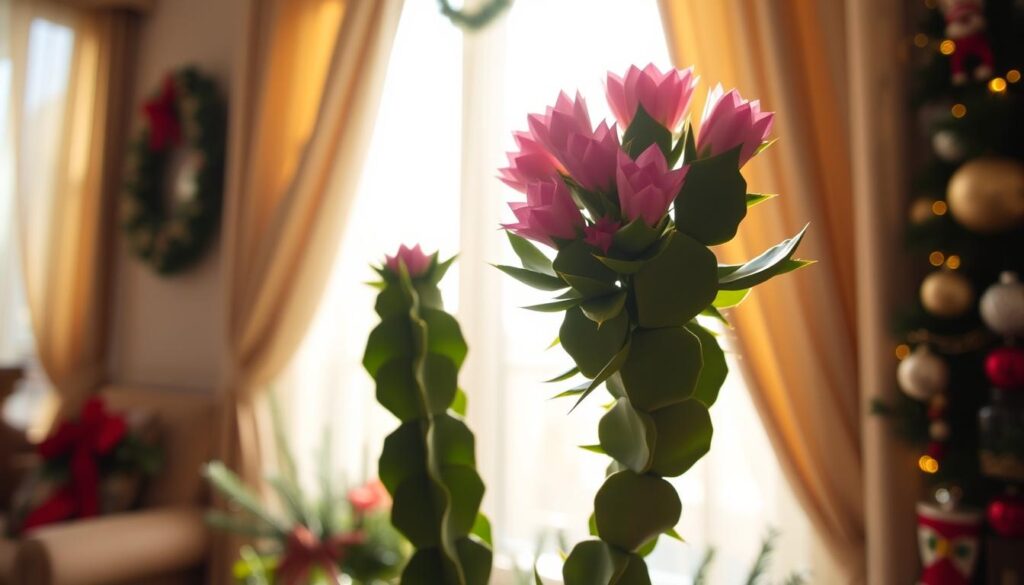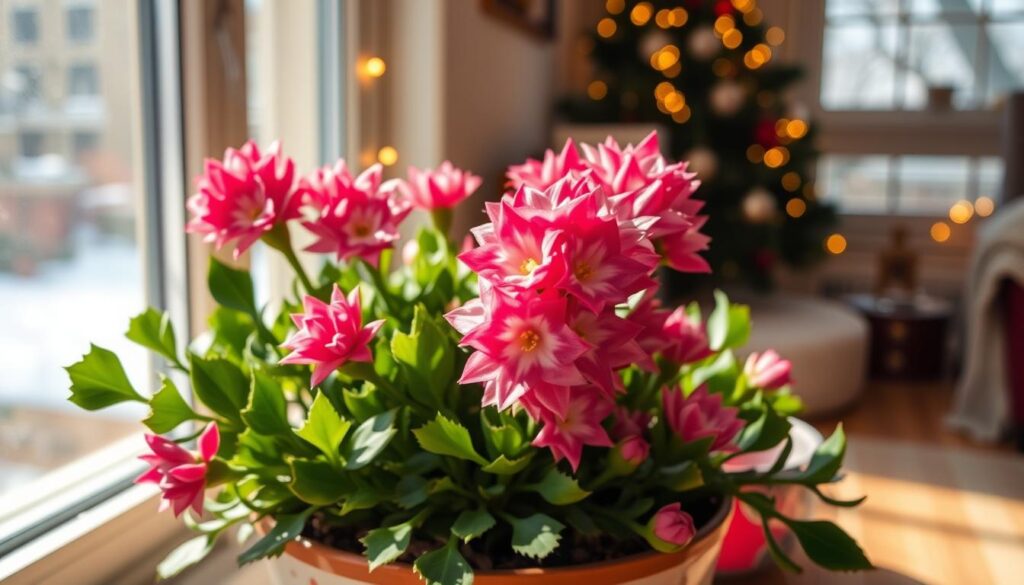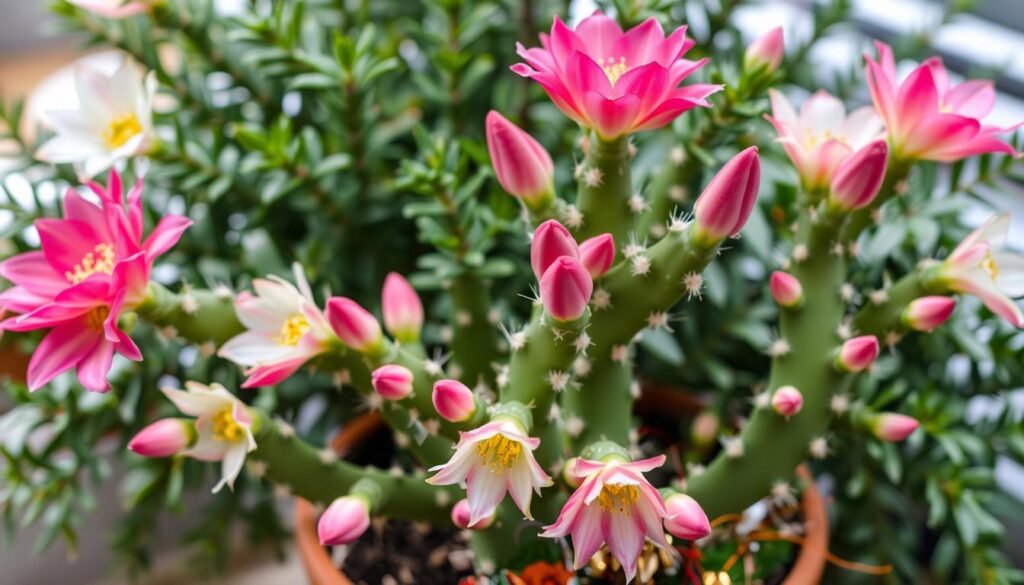Are you having trouble figuring out how often to water your Christmas cactus? You’re not alone. These plants, like the Christmas cactus, Thanksgiving cactus, and Easter cactus, need special care. They are tropical plants that need consistent moisture, unlike desert cacti. Christmas cacti thrive with regular watering.
In this guide, we’ll share the secrets to watering your Christmas cactus right. You’ll learn how to keep it blooming year after year. We’ll cover the plant’s unique needs and how to spot watering mistakes.
Key Takeaways
- Christmas cacti, unlike desert cacti, are epiphytic tropical plants that require consistent moisture and humidity to thrive.
- Watering frequency is influenced by factors like soil composition, container size, light exposure, and temperature.
- Allowing the soil to partially dry between waterings is crucial to prevent root rot and other moisture-related issues.
- Proper lighting, temperature, and humidity levels are essential for healthy growth and abundant flowering.
- Adjusting watering schedules based on the plant’s seasonal needs is key to keeping your Christmas cactus happy and blooming.
Understanding the Unique Needs of Christmas Cacti
Christmas cacti come from the rainforests of Brazil, unlike desert cacti. They are schlumbergera bridgesii, a type of epiphyte. They need different care when it comes to water and humidity.
Tropical Natives, Not Desert Dwellers
Christmas cacti love the humid rainforests of Brazil, unlike most cacti. They grow on tree branches, not in soil. This means they need more moisture and humidity to do well.
Epiphytic Growth Habit and Moisture Requirements
Christmas cacti need a moist, well-draining soil mix. This is because they grow on trees in the rainforest. Make sure not to overwater, as this can cause root rot. The soil should be moist but also dry a bit between waterings.
“Christmas cacti are tropical rainforest plants, not desert dwellers. Understanding their unique needs is key to their successful care and blooming.”
Checking the Soil for Watering Cues
Keeping the right moisture level is key for your Christmas cactus’s health and blooms. Let the potting mix dry out a bit before watering again. Check by sticking your finger into the soil – it’s time to water when the top inch or two feels dry.
Allowing Soil to Dry Between Waterings
Don’t let the soil get too dry, but also avoid keeping it wet all the time. This can cause root rot. Water your Christmas cactus when the soil is partially dry. Make sure to let any extra water drain from the bottom of the pot after each watering.
Healthy plants show bright green leaves. Limp stems and yellow leaves mean you’re watering too much. Overwatering can harm your plant. In winter, when the plant is dormant, water less to prevent root rot.
| Season | Watering Frequency | Moisture Level |
|---|---|---|
| Spring/Summer | More frequent | Keep soil consistently moist but not waterlogged |
| Winter | Less frequent | Lightly moist |
Watch the soil moisture and adjust your watering schedule. This way, your Christmas cactus will get the right amount of water. It will thrive and bloom beautifully for the holidays.

“Adapting your watering schedule to the plant’s individual needs and rhythms is key to keeping your Christmas cactus healthy and happy.”
Factors Affecting Watering Frequency
The amount of water a Christmas cactus needs changes based on a few important things. These include the type of potting mix and the size of the pot. A mix that drains well will dry out quicker than a dense one. Also, bigger pots hold water longer than smaller ones.
Potting Mix Composition and Container Size
For a Christmas cactus to be healthy, it needs a potting soil that breathes well and drains fast. This soil should be rich in organic matter to support the plant’s growth. The size of the pot also matters, as bigger pots take longer to dry out than smaller ones.
Light Exposure and Temperature
The amount of light and the temperature around the plant also affect how often it needs water. Plants in bright light or warm places need more water than those in dimmer or cooler spots. During times of growth and flowering, the plant’s water needs may increase, so it’s important to keep an eye on it and adjust watering accordingly.
| Factor | Impact on Watering Frequency |
|---|---|
| Potting Mix Composition | Well-draining, porous mixes dry out faster than dense, heavy mixes |
| Container Size | Larger containers retain moisture longer than smaller pots |
| Light Exposure | Brighter light conditions increase water needs |
| Temperature | Warmer environments lead to faster soil drying and higher watering requirements |
Knowing these factors can help gardeners better care for their Christmas cactus. This ensures their holiday cacti stay healthy and thrive.
Proper Lighting for Christmas Cacti
To make sure your Christmas cactus does well, it needs the ideal lighting. These plants love bright, indirect light. The best place for your Christmas cactus is near an east- or west-facing window, or in a bright bathroom or kitchen. Don’t let it get direct sunlight, as it can burn the leaves.
In the summer, you can put your Christmas cactus outside in a shaded spot. But, bring it back inside before the first frost. Keeping the right light is key for your cactus’s health and beautiful flowers.
Where to Place Christmas Cactus Indoors
- Near an east- or west-facing window
- In a bright bathroom or kitchen
- Avoid direct sunlight, which can scorch the leaves
By following these tips for ideal lighting for Christmas cactus, your festive plant will thrive. It will add joy to your home all season.

“Proper lighting is the key to a healthy and blooming Christmas cactus.”
Temperature Preferences for Growth and Flowering
Christmas cacti need specific temperatures to thrive and bloom. They like daytime temperatures between 70-80°F and cooler nights between 60-65°F. To get those beautiful flower buds, they need cooler nights, around 45-55°F.
Keep your Christmas cactus away from heat sources and cold drafts. Sudden changes in temperature can make the buds fall off. A stable, moderate temperature is crucial for your plant’s health and blooms.
Ideal Daytime and Nighttime Temperatures
- Daytime temperature: 70-80°F
- Nighttime temperature: 60-65°F
- Cooler nighttime temperature to stimulate bud formation: 45-55°F
By giving your Christmas cactus the right temperature, it will grow lush and bloom beautifully. This will make your holiday season even more special.
“Maintaining the right temperature balance is crucial for a thriving Christmas cactus. Exposure to the ideal conditions will reward you with a beautiful, blooming plant.”
Humidity Needs of Christmas Cacti
Christmas cacti love humid places, needing 50-60% humidity. To keep the air moist, put the pot on a tray with pebbles and water. Make sure the pot doesn’t get wet. Spraying the leaves with water is also good, but don’t overdo it.
A bright bathroom or kitchen is perfect for these plants. Use a hygrometer to check the humidity. To keep the air moist during the flowering season, use pebble trays, misting, humidifiers, and group plants together.
It’s important to keep the right humidity for your Christmas cactus to bloom well. If it’s too dry, use humidifiers, trays, or group plants. But, if it’s too wet, make sure there’s good air flow, use dehumidifiers, and pick the right spot for your plant.
| Humidity Requirements for Christmas Cactus | Ideal Humidity Range |
|---|---|
| Optimal Humidity Level | 50-60% |
| Techniques to Increase Humidity |
|
| Addressing Low Humidity |
|
| Addressing Excessive Humidity |
|
By keeping the right humidity requirements for christmas cactus and maintaining humidity for holiday cacti, you can help these plants grow well. They will bloom beautifully for the holidays.

“Proper humidity is essential for the Christmas cactus to reach its full potential and provide a beautiful display of flowers.”
Seasonal Watering Adjustments
As the seasons change, so do the watering needs of your Christmas cactus. It’s important to understand the plant’s natural growth cycle. This ensures it thrives all year long.
In the active growth period from spring to early fall, water your Christmas cactus regularly. Let the soil dry partially between waterings.
Reduced Watering During Dormancy
But when your Christmas cactus goes dormant after flowering, watering needs to drop. Keep the soil barely moist during this 4-6 week period. The plant needs less moisture to stay healthy.
When new growth appears in the spring, start watering regularly again. Adjusting your watering schedule to match the Christmas cactus’s seasonal needs helps the plant conserve energy. It prepares for its next growth spurt.
This careful consideration of the plant’s watering during different seasons is key. It’s crucial for the plant’s wellbeing and optimal flowering.
“Proper watering is essential for the health and blooming of Christmas cacti. Adjust your routine based on the plant’s growth stage for best results.”
Signs of Overwatering and Underwatering
Keeping the right amount of moisture is key for your Christmas cactus to thrive. By watching your plant closely, you can tell if it’s getting enough water.
Signs of an Underwatered Christmas Cactus
- Stunted growth
- Withering and brown leaves
- Shriveled stems
- Dry soil
- Wilting or drooping leaves
Signs of an Overwatered Christmas Cactus
- Limp leaves
- Softening stems
- Mushy roots
- Foul odor
- Potential root rot
If you see these signs, it’s time to change how you water. Plants that are too dry might need more water. On the other hand, plants that are too wet should dry out before you water again.
| Symptom | Overwatering | Underwatering |
|---|---|---|
| Leaf Appearance | Limp, drooping leaves | Wilting, shriveled leaves |
| Stem Condition | Soft, mushy stems | Shriveled, wrinkled stems |
| Root Health | Root rot, foul odor | Dry, brittle roots |
| Soil Moisture | Soggy, saturated soil | Completely dry soil |
Knowing the signs of signs of overwatered christmas cactus and signs of underwatered christmas cactus helps. This way, your Christmas cactus will get the right amount of water. It will stay healthy and look great.

How Often to Water Christmas Cactus
Watering your Christmas cactus isn’t a one-time thing. It depends on the potting mix, container size, light, and temperature. Generally, water it every 2-3 weeks when it’s actively growing.
In spring and summer, it needs more water. This is because it’s growing and making new leaves and flowers. Check the soil before watering. Water only when the top 2-3 inches are dry. Don’t let it sit in water to avoid root rot.
In winter, it needs much less water. Water it every 4-6 weeks then. Let the soil dry out more to prevent overwatering and promote growth.
Success with watering your Christmas cactus comes from watching its needs. By letting the soil dry out and providing the right moisture, your cactus will thrive and bloom every year.
Repotting and Soil Considerations
Caring for your Christmas cactus is more than just watering and lighting. The right soil and repotting are key to their health. They need well-draining, porous soil that feels like their natural home.
The best soil mix for Christmas cacti includes potting soil, bark, and sand or perlite. This mix gives them the nutrients, air, and water they need. The soil should also be slightly acidic, between 5.5 and 6.5 pH, for best nutrient uptake.
Repotting your Christmas cactus is best in the spring when it’s growing. Choose a pot with good drainage and only go up one size at a time. This keeps the plant happy and growing well.
| Soil Composition | Repotting Frequency | Ideal Pot Size |
|---|---|---|
| 2 parts peat moss, 1 part potting mix, 1 part coarse sand or perlite | Every 2-3 years | Only move up 1 pot size at a time |
With the right soil and repotting, your Christmas cactus will thrive. It will bloom beautifully for many years.

Fertilizing for Optimal Growth and Flowering
To help your Christmas cactus grow strong and bloom well, it’s key to fertilize it right. Feed it a balanced liquid or water-soluble houseplant fertilizer every 2-4 weeks in spring and summer. This gives it the nutrients it needs for healthy leaves and bright flowers.
When fertilizing christmas cactus, don’t overdo it. Too much fertilizer can make the leaves grow too much, but not enough flowers. In fall and winter, when it’s dormant, cut back on fertilizer. This stops it from growing too much and messing with its flower cycle.
- Use a balanced fertilizer with a 20-20-20 or 20-10-20 NPK ratio during the growing season.
- Supplement with Epsom salts (magnesium sulfate) every other week to meet the high magnesium needs of the epiphytic Christmas cactus.
- Stop fertilizing in late summer to avoid negatively impacting flower bud formation.
By sticking to a regular feeding schedule for holiday cacti, your Christmas cactus will get the best nutrients. This ensures it grows well and blooms plenty during the holidays.
“Fertilizing during spring and summer months helps in producing healthy growth to support flower production.”
But fertilizing is just part of caring for your Christmas cactus. You also need to keep the soil, light, and temperature right. These things are key for its health and to make it bloom well.
Pruning and Propagation Techniques
Proper pruning and propagation can greatly benefit your Christmas cactus. Prune your plant after it finishes flowering. This encourages new growth and a fuller look. Cut off a few stem sections, just above a leaf joint.
These cuttings are perfect for propagating new plants. Use cuttings over two segments for new cacti. Longer pieces, with 3-4 segments, work best for new growth.
Encouraging Branching and New Growth
When you prune, aim to remove 1-2 segments at a time. This helps your plant grow fuller. You can even cut off up to ⅓ of the plant to make it smaller. Make sure to cut just above a leaf joint to promote new growth.
Let the cuttings dry for 2-4 days before planting. Use a moist peat and sand mix for the soil. Plant them about an inch deep. It may take 2-3 weeks for roots to develop and for growth to start.

With the right pruning and propagation, your Christmas cactus will thrive. It will become lush and full, perfect for sharing. Just remember to keep it in bright, indirect light and water sparingly to avoid rot.
Troubleshooting Common Problems
Christmas cacti are tough, but they can still face issues like bud drop and root rot. Knowing what causes these problems helps keep your cactus happy and healthy.
Bud Drop
Bud drop happens when the plant loses its flower buds before they bloom. It can be caused by changes in temperature, low humidity, or uneven watering. To stop bud drop, keep the temperature steady, add moisture, and water regularly but not too much.
Root Rot
Root rot is often due to too much water. It can harm the roots and make the plant sick. If your cactus starts to wilt or turn yellow, fix the drainage, cut back on water, and treat any fungal problems.
By tackling these common issues, you can make sure your Christmas cactus stays healthy and beautiful for many seasons.
| Issue | Cause | Solution |
|---|---|---|
| Bud Drop |
|
|
| Root Rot | Overwatering leading to fungal infections |
|
“By addressing these common problems and adjusting your Christmas cactus care accordingly, you can help ensure your holiday plant thrives for years to come.”
Conclusion
To keep your Christmas cactus happy, you need to know its special needs. This includes the right amount of water, light, temperature, and humidity. By checking the soil often and adjusting care as needed, your plant will stay healthy and bloom beautifully every year.
With the right care, your Christmas cactus will become a beautiful part of your home. It adds a touch of nature and festive cheer during the holidays. By following these key care tips, you’ll enjoy your plant’s stunning flowers for many years.
Whether you’re experienced with plants or new to Christmas cacti, these tips will help. They ensure your holiday plant thrives and lasts a long time. By focusing on what these plants need, you’ll keep your Christmas cactus a joy in your home for years.


